Science Highlights, September 7, 2016
Awards and Recognition








- Dave Clark honored with Seaborg Award
- Adrienne LaFleur receives Early Career Award
- Arianna Gleason given Alvin Van Valkenburg Award
- James TenCate named Fellow of the Acoustical Society of America
- Joanna Casson wins DOE Energy Facility Contractor’s Group Award
- David Meyerhofer selected as Chair-Elect to APS Nominating Committee
- Sven Vogel appointed to Advisory Panel of European Spallation Source (ESS)
- Tony Redondo served as a panelist for the 66th annual Lindau Nobel Laureate Meeting
Accelerator Operations and Technology
Dynamic behavior of additive manufactured lattice materials measured
Educational Outreach
Students spread the word about sample gathering for a pathogen detection project
Materials Physics and Applications
Light-activated photocurrent degradation and self-healing in perovskite solar cells
Awards and Recognition
Dave Clark honored with Seaborg Award
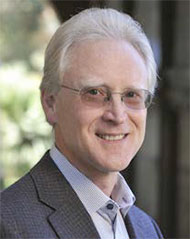
David L. Clark (National Security Education Center, NSEC) has been selected as the 2017 recipient of the Glenn T. Seaborg Award for Nuclear Chemistry, sponsored by the American Chemical Society Division of Nuclear Chemistry and Technology. The award recognizes outstanding contributions to nuclear chemistry or radiochemistry or to their applications. He was honored for his innovative systematic studies of the fundamental chemistry of actinide elements using novel experimental techniques and giving new insights into the chemical bonding of 5f electrons.
Clark is an internationally recognized authority on the chemistry and physics of radioactive actinide elements, with an emphasis on plutonium. He has brought state-of-the-art molecular level understanding to the chemistry of the actinides and applied that understanding to unravel the behavior of actinide ions in chemical solutions or the environment. Those efforts were applied to the original scientific case for the Waste Isolation Pilot Plant (WIPP) and to the environmental cleanup of the Rocky Flats Site. He has studied chemical bonding and the use of x-ray spectroscopy at synchrotron light sources to examine the role of 5f electrons in chemical bonding. More than 165 peer-reviewed publications with nearly 7,000 citations report his work.
Clark is a Fellow of the American Association for the Advancement of Science and of Los Alamos National Laboratory. He has received two NNSA Defense Programs Awards of Excellence and a Laboratory Fellow’s Prize. This is Clark’s second national-level American Chemical Society award, the first being the Nobel Laureate Signature Award in Graduate Education in Chemistry, awarded for his Ph.D. thesis work.
David Clark received a Ph.D. in inorganic chemistry from Indiana University. He was a postdoctoral fellow at the University of Oxford before joining Los Alamos as a J. Robert Oppenheimer Fellow in 1988. He became a Technical Staff Member in the Isotope and Nuclear Chemistry Division in 1989.
Clark has held Lab leadership positions, including program management for Nuclear Weapons and Office of Science programs and inaugural Director of the Glenn T. Seaborg Institute for Transactinium Science. Currently, he is Director of the National Security Education Center and leads the Plutonium Science and Research Strategy for LANL. Clark also has served the DOE as a technical advisor for environmental stewardship including the Rocky Flats cleanup and closure, closure of High Level Waste tanks at the Savannah River Site, the DOE High Level Waste Corporate Board, and DOE’s Environmental Management Technical Expert Group.
The American Chemical Society, the largest scientific society in the world, will present Clark with the award at the 253rd ACS National Meeting and Exposition in San Francisco, CA in April 2017. Previous recipients of the Glenn T. Seaborg Award in Nuclear Chemistry from Los Alamos include Arthur C. Wahl and Darleane C. Hoffman. Technical contact: David Clark
Adrienne LaFleur receives Early Career Award
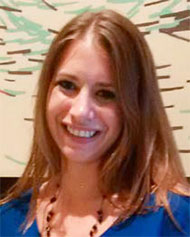
The Institute of Nuclear Materials Management (INMM) presented Adrienne LaFleur (Safeguards Science and Technology, NEN-1) with an Early Career Award for her contributions to the nonproliferation community. LaFleur’s work focuses on international safeguards, particularly in support of the International Nuclear Safeguards Engagement Program, as well as other nonproliferation efforts. INMM honored her with the Award during its 57th Annual Meeting in Atlanta, GA.
The Early Career Award recognizes members of INMM who are 35 years of age or younger and who have made singular on a Department of Homeland Security scholarship in the Chemistry Division in 2006, performing particle analysis of depleted uranium oxides to determine processing signatures, and also working with NEN-1 on reactor burnup code calculations related to nuclear forensics. She became a technical staff member at the Lab in 2011 after earning a Ph.D. in nuclear engineering and a certificate in advanced international affairs from Texas A&M University. LaFleur has written or co-authored several articles and textbook chapters. She was chosen as Fellow for a World Nuclear University Summer Institute, an intensive six-week program focused on peaceful nuclear applications for promising nuclear professionals who have demonstrated strong leadership potential.
LaFleur has extensive experience in all key safeguards measurement instrument development cycle aspects: technical method development, instrument design, fabrication, calibration, installation, and data analysis from nondestructive assay (NDA). For example, LaFleur worked with the Chernobyl Nuclear Power Plant to develop a new NDA system to measure the plutonium in waste drums and a neutron/gamma verification monitor for the new safe confinement shelter that was built and soon will be installed over the old Unit 4 reactor shelter. LaFleur is the principal developer for the boron and helium tube continuous neutron monitor that has been deployed at the Plutonium Conversion Development Facility in Japan. She is the key participant in the DOE-Japan Atomic Energy Agency (JAEA) program to apply safeguards verification measurements to the recovery of debris from the Fukushima nuclear accident. Moreover, she has frequently served as a subject matter expert instructor of LANL training courses for inspectors from the International Atomic Energy Agency (IAEA) as well as domestic NDA training courses.
The Institute of Nuclear Materials is an international professional society dedicated to development and promulgation of practices for the safe, secure and effective stewardship of nuclear materials through the advancement of scientific knowledge, technical skills, policy dialogue and enhancement of professional capabilities. Nuclear materials management involves the production, use, storage, transport, handling, protection, accounting and other essential aspects involved with the fundamental elements of the civilian nuclear fuel cycle, most notably, uranium and plutonium. LaFleur served as Vice-President and President of the Student Chapter of INMM at Texas A&M while she was a graduate student. Technical contact: Adrienne LaFleur
Arianna Gleason given Alvin Van Valkenburg Award
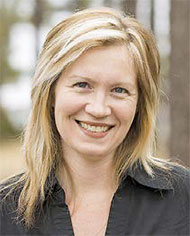
The 2016 Gordon Research Conference on High Pressure in Holderness, NH has presented the Alvin Van Valkenburg Award to Arianna Gleason (Shock and Detonation Physics, M-9). She received this honor for her substantial contributions as an early career scientist to high-pressure physics in both static and dynamic compression. Gleason presented a talk “Ultrafast X-ray Studies on the Dynamics of Transitions in Geophysical Materials” after receiving the Alvin Van Valkenburg Award.
Gleason’s research has focused on the strength of iron at planetary core conditions. She used radial x-ray diffraction to investigate the strength of iron at high pressure in a diamond anvil cell under static compression. This study provided high fidelity measurements of iron’s strength. Extrapolation to conditions of the Earth’s center suggests that the core is much weaker that previously expected. Gleason has extended her research from static compression into the regime of dynamic compression. She has performed an experiment using x-ray diffraction at the Linac Coherent Light Source at the SLAC National Accelerator Laboratory to probe the strength of iron at both high pressure and high temperature using laser-driven shock compression.
Gleason began conducting scientific research in 1998 on asteroid/comet detection and discovery with the group Spacewatch at the University of Arizona. She received a Ph.D. from the University of California – Berkeley in mineral physics and Earth sciences for her investigation of the elasticity and plasticity of Earth-relevant materials at extreme conditions. Gleason used static compression techniques combined with synchrotron sources. The work helps interpret Earth’s seismic information and provides insight into the evolution of the Earth’s interior. She joined the Lab in 2014 as a Postdoctoral Fellow, and received the Reines Distinguished Postdoctoral Fellow in 2015. Cindy Bolme (M-9) and Professor Wendy Mao (Stanford University) co-mentor her. The American Geophysical Union has presented her with the Early Career Award in Mineral and Rock Physics. Nature Geoscience and Nature Communications have published her research.
The Research at High Pressure Conference is one of the oldest Gordon Research Conferences and has existed continuously for over 60 years. High pressure provides the largest range of any tunable thermodynamic variable to change and study material properties. The conference presents the Alvin Van Valkenburg Award to honor an early career scientist who shows great promise to further the field of high pressure. Alvin Van Valkenburg invented the diamond anvil cell and was a pioneer in high pressure research. Technical contact: Arianna Gleason
James TenCate named Fellow of the Acoustical Society of America
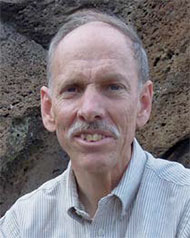
The Acoustical Society of America (ASA) has elected James Tencate (Geophysics, EES-17) as Fellow. The ASA cited him “for contributions to nonlinear acoustics of earth materials.”
TenCate’s work focuses on nonlinear acoustics and elasticity, seismology, and nonlinear imaging. “Nonlinear” indicates that the change in one factor (such as stress) is not proportional to the change in another (such as strain); therefore such change is less predictable. Nonlinear acoustics can be applied to the formation of shock waves, harmonic distortion, and paths to chaos. TenCate performs nonlinear elastic wave experiments that reveal the unusual behavior of rocks and geomaterials. His work supports nonproliferation, more efficient fossil energy production, geophysics, nondestructive testing, general linear and nonlinear acoustic diagnostics, and the Los Alamos Seismic Network. He also works with elastic waves.
TenCate received a Ph.D. in mechanical engineering from the University of Texas with a specialization in physical acoustics. He began his career modeling wave propagation of sonic booms and then transitioned to using underwater acoustics (including large sound waves) for detecting submarines. TenCate joined Los Alamos in 1994 to study the geophysics of oil and gas reservoirs. Now he works with acoustic signatures and also uses nonlinear acoustic imaging for both non-destructive testing and evaluation and imaging for oil and gas research.
International members of the ASA work in a variety of fields related to sound, including Earth and life sciences, engineering, and the arts. More information here. Technical contact: James TenCate
Joanna Casson wins DOE Energy Facility Contractor’s Group Award
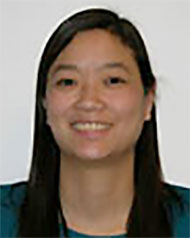
The DOE Energy Facility Contractor’s Group (EFCOG) presented Joanna Casson (Physical Chemistry and Applied Spectroscopy, C-PCS) the Group award for her contributions in laser safety. The award recognized Casson as part of a team that included representatives from six DOE Labs and DOE. She was the only LANL participant. Casson received the award during a ceremony at the Annual Meeting in Washington, D.C.
The team updated the 2005 DOE Laser Safety Course. So much has changed since the course was created that it required complete redevelopment. Casson and the team re-designed and developed a course that will strengthen laser knowledge and laser safety in DOE facilities for many years to come. The course is published and available to the entire DOE Community on the DOE National Training Center (NTC) production server as ESH-518, DOE Laser Worker Training.
Dean Decker (DOE Los Alamos Field Office) nominated her for the award. EFCOG promotes excellence in the operation, management, and integration of DOE facilities. Casson is an Industrial Hygiene and Safety Professional in Chemistry Division and the LANL subject matter expert for Laser Safety. She joined the Lab 20 years ago. Technical contact: Joanna Casson
David Meyerhofer selected as Chair-Elect to APS Nominating Committee
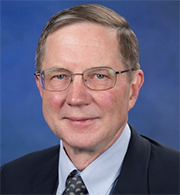
The American Physical Society (APS) has chosen David Meyerhofer (Physics Division Leader, P-DO) to be the Chair-Elect of the Nominating Committee. The Chair-Elect serves a one-year term, followed by a one- year term as Chair, then a one-year term as the most recent Past Chair.
Meyerhofer became an APS Fellow in 2002. He chairs the APS Division of Plasma Physics (DPP) and has completed a 4-year term on the APS Committee on Scientific Publications. Meyerhofer has participated on APS/DPP Committees and was an APS/DPP Distinguished Lecturer, Associate Editor for plasma physics in Reviews of Modern Physics , and Divisional Associate Editor for Physical Review Letters . He has served on the National Research Council’s Board on Plasma Science and Committee on High Energy Density Plasma Physics, and on DOE panels.
Meyerhofer earned a Ph.D. in Astrophysical Sciences/Plasma Physics from Princeton University. Prior to joining LANL in 2015, he spent 28 years at the University of Rochester as Professor of Mechanical Engineering and of Physics. His experimental research interests include high energy density and plasma physics, inertial confinement fusion, and the nonlinear interaction of high intensity lasers with atoms, electrons, and the vacuum.
The American Physical Society is a non-profit membership organization formed in 1899. It works to advance and diffuse the knowledge of physics. APS represents over 51,000 members worldwide, including physicists in academia, national laboratories, and industry. The Nominating Committee prepares a slate of candidates for the Vice President, Treasurer, Chair -Elect of the Nominating Committee, the vacant positions of General Councilor and International Councilor, and other positions specified by the Board or the Council. Technical contact: David Meyerhofer
Sven Vogel appointed to Advisory Panel of European Spallation Source (ESS)
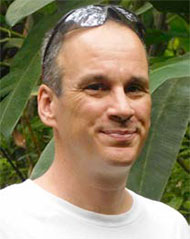
Ken Andersen, head of the Neutron Instruments Division of the European Spallation Source (ESS), has appointed Sven Vogel (Materials Science in Radiation and Dynamics Extremes, MST-8) to the Scientific and Technical Advisory Panel for Engineering and Imaging of the European Spallation Source. The ESS is under construction in Lund, Sweden. Once operating, the ESS at full power will be the most powerful neutron source in the world. Vogel will advise on the design of the ODIN imaging beamline and the engineering diffractometer BEER. He was selected for his expertise in both engineering neutron diffraction and advanced neutron imaging techniques. His appointment is for two to four years.
Vogel received a Ph.D. in physics and a diploma in mineralogy at Christian-Albrechts-University Kiel. He joined LANL as a postdoctoral researcher commissioning the SMARTS (Spectrometer for Materials Research at Temperature and Stress) diffractometer in 2001. Vogel became a staff member in 2002. He is the instrument scientist for the HIPPO (high pressure/preferred orientation) time-of-flight neutron diffractometer and the energy-resolved neutron imaging beam line at the Los Alamos Neutron Science Center (LANSCE). Technical contact: Sven Vogel
Tony Redondo served as a panelist for the 66th annual Lindau Nobel Laureate Meeting

Tony Redondo of the Associate Directorate for Theory, Simulation, and Computation (ADTSC), attended the 66th Lindau Nobel Laureate Meeting that took place on June 26th through July 1st in Lindau, Germany. He was a panelist on the topic of Soft Matter.
Since their start in 1951, the Lindau Meetings have evolved into a unique international forum for scientific exchange. Once every year, about forty Nobel Laureates convene at Lindau to meet the next generation of leading scientists including undergraduates, Ph.D. students, and post-doc researchers from all over the world. The Meetings foster the exchange among scientists of different generations, cultures, and disciplines. This years’ meeting was dedicated to the field of physics. A total of 29 Nobel Laureates, Vinton G. Cerf (ACM A.M. Turing Award recipient), and a small number of panelists met with 400 young scientists from 80 countries.
Redondo served as a panelist on a Science Breakfast (panel discussion) titled “Why does soft matter matter?” The two other panelists were Professor Steven Chu (Stanford University and a former U.S. Secretary of the DOE) and Adriana Marais (University of KwaZulu-Natal, South Africa). More than 100 young scientists attended the panel discussion.
Redondo received a Ph.D. in Applied Physics from the California Institute of Technology and began his career at LANL in 1983 as a technical staff member in the Electronics and Electrochemical Materials Devices Group. He served as the Theoretical (T) Division Leader from 2006 to 2015, and is currently a senior scientist in ADTSC. His research interests focus on modeling soft matter, biomaterials, and biofuels using a combination of classical continuum and atomistic approaches. Technical contact: Tony Redondo
Accelerator Operations and Technology
Dynamic behavior of additive manufactured lattice materials measured
Additive manufacturing (AM) enables the fabrication of materials with engineered lattice structures at the micron scale. The mesoscopic structures fall between the length scale associated with the organization of atoms and the scale at which macroscopic structures are constructed. The relation of the fundamental length scales associated with the emergence of continuum behavior in a material that is more open space than solid and the time-dependent properties related to energy absorption under high velocity ballistic impact or application to high-speed devices are unknown. A research team conducted dynamic compression experiments to study the emergence of behavior owing to the lattice periodicity in AM materials on length scales that approach a single unit cell. The investigators aimed to understand the fundamental properties of the time-dependent response of these materials. Scientific Reports published their findings.
The physical world is filled with cellular structures – both human-made (e.g., truss bridges) and of natural origin (e.g., porous bone tissue). These entities demonstrate a material response that is optimized through topology rather than composition. Conventional materials design relies on manipulation of chemistry or phase fractions (for multi-phase systems) or microstructural length scales, such as grain size distributions. The advent of additive manufacturing allows manipulation of the architecture of the cellular material to impart order and periodicity into materials at the mesoscopic scale and go beyond the notion of simply seeding random porosity. The ability to organize the structure and composition at the mesoscopic scale enables the custom design of materials by applying structural engineering principles, such as truss theory, at the micron length scale. This presents the possibility of designing and engineering material properties to precisely meet the demands of the intended application. In order to predict and optimize the properties of these materials and enable applications, thorough characterization is necessary. Measurements of the emergence of continuum behavior in the material and the time dependent properties are needed.
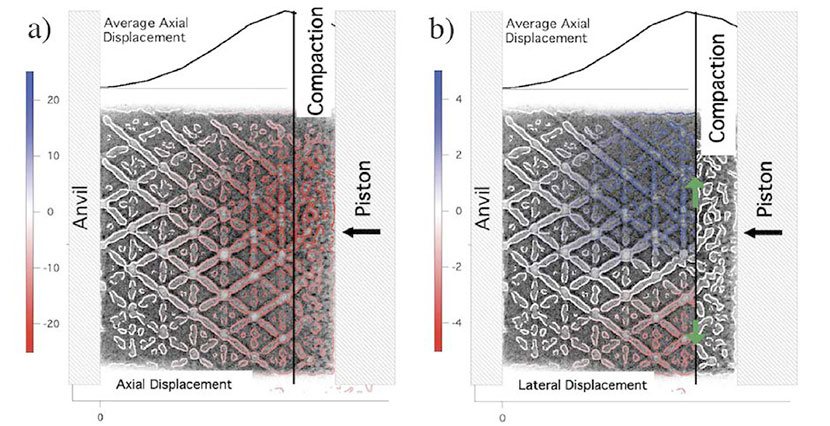
Figure 6. Lattice displacements based on a point-‐to-‐point displacement analysis shown axially in a) and laterally in b). Lateral displacement is small and consistent with stress relief at the open surfaces.
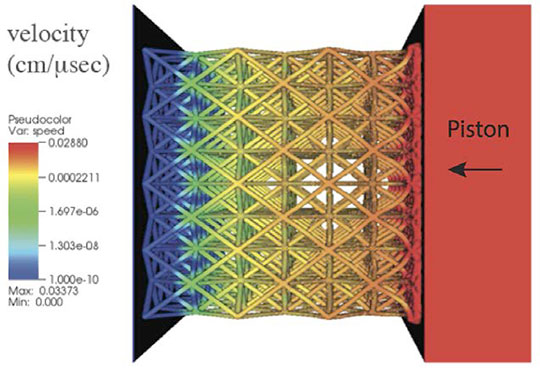
Figure 7. Finite element simulation where the color scale indicates the material velocity in the x-direction. Note: the colors are on a log scale.
The team performed dynamic loading experiments at the Dynamic Compression Sector at Argonne National Laboratory’s Advanced Photon Source (APS) on arrays of additively manufactured 4×4×6 lattice unit cells. Dynamic loading conditions are characterized by large gradients in stress and strain where the length scale of these gradients is smaller than the engineered lattice unit cell size. The results revealed that both bend and stretch dominated. These additively manufactured micron lattices also showed unique mechanical properties that are not found in naturally occurring, disordered cellular materials. The shock loading tests proved that elastic deflection of the structure happened before lattice compaction, and that no elastic deformation preceded the compaction in a stochastic, random structure.
The researchers ALE3D, an arbitrary Lagrangian-Eulerian finite element package developed by Lawrence Livermore National Laboratory, to conduct finite element simulations of the octet truss structure of the AM material. The simulations included periodic boundary conditions. Similar to the experiments, the simulated compression waves in all the three octet lattice structures develop the same two-front behavior – a faster front associated with elastic deformation and a slower front associated with compaction. Figure 7 depicts the simulation of the <100>-orientated octet lattice at a time after impact, when the two fronts have separated. The fringe colors show the material velocity in the x-direction. The sharp increase in material velocity well ahead of the impactor indicates the elastic front. The computed speeds from simulation and theory closely match the speeds observed in the experiments. In the simulation the elastic front amplitude is observed to decay and the front speed decreases over time in simulations of much longer lattices than the samples used in the experiments. This result suggests that the lattice topology may cause attenuation and dispersion that affect the elastic wave.
The measurement and an understanding of collective behavior on short length and fast time scales is critical to building accurate models of the response of AM structured materials. The basic approach is to use the collective properties of an engineered structure at the micron scale to influence the behavior of a material. The key aspect is to gain an understanding of when the collective properties of the impose structure emerge. Conventional thought would suggest that collective properties only emerge in applications where the length scale of interest is large compared to the lattice length scale. These observations show that the elastic and compaction behavior exhibits collective response rapidly under shock loading. The team concludes that the material response could be treated as classical elastic-plastic deformation even though the stress and strain gradients are much smaller than a unit cell.
These results are a step toward the ability design and engineer a material with properties to precisely meet the demands of the intended application. Los Alamos refers to this concept as controlled functionality, which is the central vision of the Laboratory’s materials strategy. LANL anticipates the advent of a new era in materials science, when researchers will transition from observing and exploiting the properties of materials to a science-based capability that creates materials with properties optimized for specific functions.
The work is an example of the capability offered by MaRIE, LANL’s proposed Matter-Radiation Interactions in Extremes facility. Researchers could use MaRIE to extend this work to study more complex AM materials such as explosives and higher density metals, which would require greater photons counts per pulse and higher energies to image through these materials during dynamic loading.
Reference: “Dynamic Behavior of Engineered Lattice Materials,” Scientific Reports 6, 28094 (2016); doi: 10.1038/srep28094. Authors: J. Lind, B. Maddox, M. Barham, M. Messner, N. Barton and M. Kumar (Lawrence Livermore National Laboratory); J. A. Hawreliak (Lawrence Livermore National Laboratory and Washington State University); and B. J. Jensen (Shock And Detonation Physics, M-9).
The NNSA funded the Los Alamos work, which supports the Nuclear Deterrence mission area and the Materials for the Future and Science of Signatures science pillar through the development of additive manufacturing for materials of controlled functionality and methods to characterize these materials. This publication is based in part upon work performed at the Dynamic Compression Sector at the Advanced Photon Source supported by the NNSA. The team used resources of the Advanced Photon Source, a DOE Office of Science User Facility operated for the DOE Office of Science by Argonne National Laboratory. Technical contact: B. J. Jensen
Earth and Environmental Sciences
Ice-wedge degradation in warming permafrost
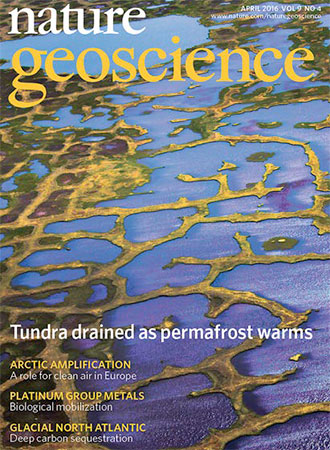
Figure 1. Photo of polygonal tundra of the Alaskan North Slope near Barrow photographed from a small research airplane. The polygonal patterns in permafrost regions are caused by the formation of ice wedges. At the landscape scale, wedge ice is estimated to represent approximately 20% or more of the uppermost permafrost volume. Observations of polygon evolution reveal that rapid ice wedge melting has occurred across the Arctic since 1950, altering tundra hydrology.
A publication in Nature Geoscience and the journal cover describe the relationship between ice-wedge degradation and tundra hydrology in a warming climate. The authors include Cathy Wilson (Earth System Observations, EES-14) and collaborators. The work was published in conjunction with the Next-Generation Ecosystem Experiments (NGEE)-Arctic program, which investigates high-latitude regions of the world to better understand and model ecosystem-climate feedbacks.
Ice wedges are common subsurface features in permafrost regions. The wedges form when snowmelt water infiltrates into thermal contraction cracks and freezes. Repeating this process for many years forms a wedge-shaped ice body that eventually causes the formation of polygonal relief development that is common across the Arctic landscapes. Ice wedges grow over centuries to thousands of years, but melting of the uppermost portion can occur within decades.
These regions contain “cold permafrost,” with an overall average temperature of roughly -14 oC. On-site observations of eleven Arctic sites showed widespread ice-wedge degradation during recent decades in ten of the eleven sites surveyed in this study. Field observations across a wide range of Arctic sites (including Arctic Alaska, Siberia, and High Arctic Canada) recorded ice-wedge degradation via several markers, including a mismatch between vegetation type and soil moisture regime, changes in vegetation composition, and ponding or drying and ground subsidence. In particular, changes in vegetation type indicate lasting morphological and hydrological changes. The team combined on-site observations with high-resolution remote sensing imagery, which showed changes to surface wetness and the appearance or disappearance of small ponds. All of these observations suggest a general morphological evolution that is characterized by the absence or presence of lateral surface water connectivity and landscape drainage.
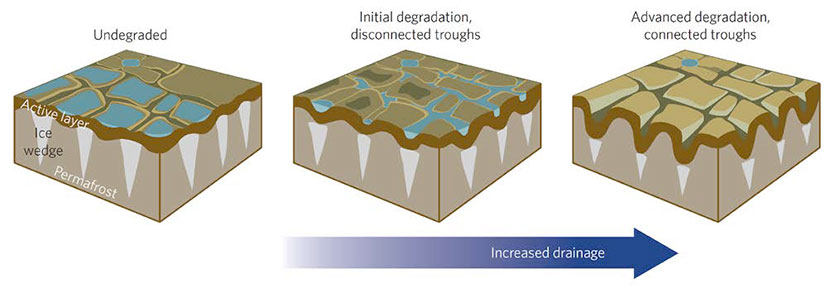
Figure 2. Representation of polygon succession, where increased drainage leads to advanced degradation and connected troughs that may result in drainage across portions of the landscape.
The team documented changes that reveal evidence of the sub-decadal timescale of ice-wedge degradation. Examples of this landscape evolution include two sites. (1) Prudhoe Bay had a relatively stable landscape from 1949 to the mid-1980s. The majority of flooded troughs appeared within an 11-year time period (1990-2001), which was followed by an expansion of trough ponds from 2001 to 2010. (2) At the Canadian site, vegetation study plots established in 2005 on non-patterned surface had transformed into mounds surrounded by troughs by 2013. Transition to the advanced stage with connected troughs ranged from 8 to 40 years.
The authors also incorporated field measurements and LiDAR (Light Detection and Ranging)- derived topography into numerical model experiments to help refine the models to assess the impacts of ice-wedge degradation on watershed-scale hydrology. The researchers observed that morphological change, in particular the development of mounds and laterally connected troughs (and its effect on snow distribution), could significantly increase runoff and reduce water-covered area, even when all other variables are held stable. An increased abundance of trough ponds and a decrease in polygon center-ponds can lead to ground subsidence.
This is the first study to determine that ice wedge melting is widespread across the Pan-Arctic on subdecadal time scales. The team’s model simulations support the morphological changes observed. The researchers conclude that the development of mounds and laterally connected troughs and its effect on snow distribution can alone significantly increase runoff and reduce water covered area. Ground subsidence has the potential to significantly impact the regional ecosystem because ice-rich permafrost may underlie up to two-thirds of the terrestrial Arctic. In addition, the authors suggest that increased variability in weather initiated by pulse atmospheric forcing may promote ice-wedge degradation to a larger extent than gradual climate warming alone.
Reference: “Pan-Arctic Ice-Wedge Degradation in Warming Permafrost and Its Influence on Tundra Hydrology,” Nature Geoscience 9, 312 (2016); doi: 10.1038/ngeo2674. Authors: Anna K. Liljedahl, Ken D. Tape, Larry D. Hinzman, Martha K. Raynolds, and Donald A.Walker (University of Alaska – Fairbanks); Julia Boike and Guido Grosse (Alfred Wegener Institute Helmholtz Centre for Polar and Marine Research); Ronald P. Daanen (Alaska Department of Natural Resources); Alexander N. Fedorov (Melnikov Permafrost Institute); Gerald V. Frost (ABR Inc.); Yoshihiro Iijma and Hironori Yabuki (Japan Agency for Marine-Earth Science and Technology); Janet C. Jorgenson (Arctic National Wildlife Refuge); Nadya Matveyeva (Russian Academy of Sciences); Marius Necsoiu (Southwest Research Institute); Vladimir E. Romanovsky (University of Alaska – Fairbanks and Earth Cryosphere Institute); Jörg Schulla (Hydrology Software Consulting); Cathy J. Wilson (EES-14); and Donatella Zona (San Diego State University and University of Sheffield).
The Office of Biological and Environmental Research in the DOE Office of Science funded the LANL research, which supports the Lab’s Energy and Global Security mission areas and the Science of Signatures science pillar through development of methods to detect the impact of climate change. More information about the NGEE-Arctic program: http://ngee-arctic.ornl.gov/ Technical contact: Cathy Wilson
Educational Outreach
Students spread the word about sample gathering for a pathogen detection project
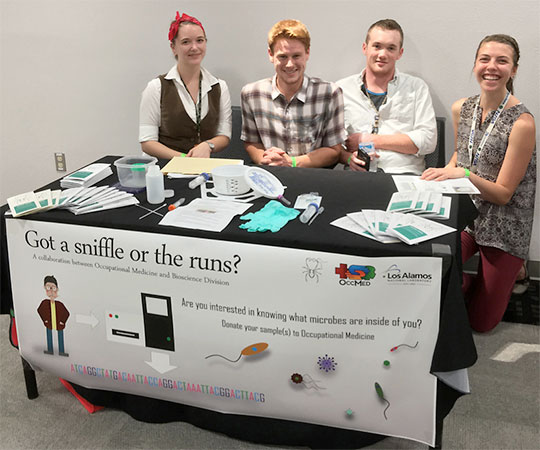
Photo: Students James Horne, Emily Innis, Ryan Toma, and Brittany Twibell give information and answer questions.
During the 2016 Worker Safety and Security Teams (WSST) Fest, Bioscience Division students James Horne, Emily Innis, Ryan Toma, and Brittany Twibell talked to LANL employees about donating their bodily fluids – all in the name of science. The students are working with their mentors Momo Vuyisich and Patrick Chain (Biosecurity and Public Health, B-10) and Laboratory Medical Director Sara Pasqualoni (Environment, Safety, and Health, ADESH) on a project called SPIDR-WEB, which aims to revolutionize infectious disease diagnostics. SPIDRWEB (Sample Preparation for Infectious Disease Recognition - With EDGE Bioinformatics) is a sample-to-result biotechnology platform that identifies and characterizes all pathogens in human clinical samples. To validate the platform, the team requires clinical samples – blood, respiratory, urine, or stool – for the technique to test. The students told WSSTFest participants that they could help the project by donating samples at LANL’s Occupational Medicine. They are only seeking volunteers who feel ill and have clear signs of an infectious disease. The volunteers can learn what is causing their illness and a list of all of the microbes currently coexisting in their body.
Why is this needed? Current methods of detecting and diagnosing disease require a doctor to make an educated guess about what disease a person might have before they can order a test to confirm. For instance, when a patient presents coughing and a fever in the middle of February, the doctor might order a flu test. Most tests can only detect one or a few pathogens. Unless the doctor has a pretty good idea about which test to order, patients often get a more general diagnosis such as “upper respiratory virus”. This is problematic because symptoms overlap in many diseases. In addition, lack of clear diagnosis can lead to viral infections being erroneously treated by antibiotics, which could cause antibiotic resistance.
The SPIDR-WEB approach uses genomic sequencing to identify all the microbial organisms (bacteria, viruses, yeast, fungi) in a sample – including ones that commensally live there all the time. This way, a doctor does not have to pre-determine what the affliction might be. The test characterizes everything based on databases of known organisms, enabling the exact pathogen(s) to be identified. SPIDR-WEB could also identify emerging diseases that might not have been previously known.
The SPIDR-WEB approach is built on unique Los Alamos expertise in two areas: sample preparation and bioinformatic analysis. The team needs more clinical samples from sick patients to validate the platform. Any LANL employee with an active Z# who is feeling ill can help by donating fluids or solids at Occupational Medicine. All samples are kept anonymous. Although the results cannot be used as an official diagnosis, patients will receive a full list of the organisms that SPIDR-WEB found.
SPIDR-WEB enables efficient use of next generation sequencing (NGS) for pathogen detection in clinical samples. In most clinical samples, the relative abundance of pathogen nucleic acids (DNA or RNA) is vanishingly small. Therefore, vast amounts of sequence data must be generated and analyzed to identify rare pathogen sequences. SPIDR-WEB relies on efficient laboratory and in silico steps. SPIDR-WEB incorporates removal of non-informative RNAs, thereby enriching all other RNAs, including those from pathogens. This step enables either higher sensitivity and specificity, or less expense and faster sequencing. The custom EDGE bioinformatics data analysis platform provides rapid read classification at all taxonomic levels, and reliably detects all organisms present in a sample. EDGE works efficiently because it uses databases with pre-computed signatures, instead of aligning sequencing reads to the entire Genbank. SPIDR-WEB also includes robust, inexpensive and rapid sample lysis, RNA extraction, and library preparation steps.
In addition to Vuyisich, Horne, Innis, Toma, and Twibell; other Laboratory researchers who developed SPIDR-WEB include Andrew Hatch, Chien-Chi Lo, Cheryl Gleasner, Paul Li, Kim McMurry, Patrick Chain, and Jason Gans (B-10).
The DoD Defense Threat Reduction Agency (DTRA) and Laboratory Directed Research and Development (LDRD) program funded different aspects of the SPIDR-WEB project, which supports the Lab’s Global security mission area and Science of Signatures science pillar through the development of pathogen detection and identification. Technical contact: Momo Vuyisich
Materials Physics and Applications
Light-activated photocurrent degradation and self-healing in perovskite solar cells
Hybrid perovskite materials have excellent opto-electronic properties for a wide variety of device applications. However, these materials have some stability challenges to overcome. Los Alamos researchers and collaborators have found both the cause and a solution for the tendency of perovskite solar cells to degrade in sunlight. The team discovered that this photo-degradation is a purely electronic process due to charge accumulation without chemical damage to the crystal structure. Therefore, this process can be circumvented, while the cells’ self-healing properties allow them to rebound in the dark. This finding could potentially remove one roadblock to commercialization for this promising technology. The journal Nature Communications published the research.
The team is exploring organometallic halide semiconducting perovskite solar cells. They are promising due to their high power conversion efficiency (PCE) exceeding 20% and low fabrication costs. The perovskite material can be synthesized via a low-temperature solution process using earth-abundant compounds. To move the material from proof-of-concept experiment to market-viable technology requires the device to operate at stability under continuous sunlight and in outdoor conditions. The sunlight-induced degradation undermines the commercialization of perovskite-based solar cells.
The researchers performed extensive device and spectroscopy characterization. They discovered that sunlight triggers the activation of meta-stable trap states at relatively low energy deep in the perovskite bandgap, which results in the trapping of photo-generated charge carriers. Over time, trapped carriers can further accumulate in the device, and thus reduce the photocurrent. Placing the solar cell devices in the dark for several minutes allows for “evacuation” of these trapped charges, leading to the recovery of the pristine device performances upon the next operation cycle. The team also found that these processes are strongly temperature dependent and that temperature control over a range of a few tens of degrees can either prevent the activation of the photodegradation mechanisms or increase the speed of the self-healing process. . The degradation of the devices can be suppressed by simply lowering the temperature by a few degrees, i.e., from 25 oC to 0 oC.
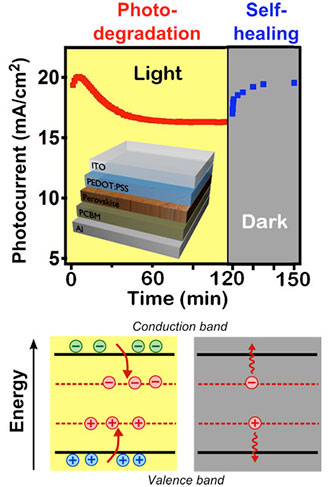
Figure 3. (Top): Organometallic halide perovskite solar cells demonstrate photocurrent-degradation under sunlight and self-healing in the dark. (Bottom): Illustration of the light activation of meta-stable trap states during photo-degradation and curing of these traps during self-healing.
The researchers concluded from the joint experimental and theoretical investigations that the most possible scenario is the creation of small polaronic states involving lattice strain and molecular re-orientations of the organic cation present in the perovskite lattice. The team’s future experiments will focus on improvements and the long-term technological viability of perovskite-based photovoltaics.
Reference: “Light-activated Photocurrent Degradation and Self-Healing in Perovskite Solar Cells,” Nature Communications 7, 1574 (2016); doi:10.1038/ncomms11574. Authors: Wanyi Nie, Hsinhan Tsai, Gautam Gupta, and Aditya Mohite (Materials Synthesis and Integrated Devices, MPA-11); Jean-Christophe Blancon and Jared Crochet (Physical Chemistry and Applied Spectroscopy, C-PCS); Amanda Neukirch and Sergei Tretiak (Physics and Chemistry of Materials, T-1); Kannatassen Appavoo and Matthew Sfeir (Brookhaven National Laboratory); Manish Chhowalla (Rutgers University); Muhammad Alam (Purdue University); Claudine Katan (Université de Rennes); and Jacky Even (INSA de Rennes, France).
The DOE Office of Basic Energy Sciences and the Los Alamos Laboratory Directed Research and Development (LDRD) program funded the Los Alamos portion of the work, performed in part at the Center for Integrated Nanotechnologies (CINT), a DOE Office of Science User Facility. Computational and DFT (density functional theory) calculations used resources provided by the Los Alamos Institutional Computing Program, supported by the DOE NNSA. This work supports the Lab’s Energy Security mission areas and the Materials for the Future science pillar through the development of materials for clean energy. Technical contact: Aditya Mohite
Materials Science and Technology
SMARTS reveals residual stresses in additively manufactured parts

Photo. Stainless steel samples additively manufactured on a steel base plate. A sample near the edge tore away from the base plate during the build.
Additive manufacturing is an agile model for designing, producing, and implementing the process-aware materials of the future. The process enables innovative design options that were once impossible to fabricate. However, the processing-structure-property-performance relationships of the materials must be determined to enable optimization for applications. A team conducted experiments at the Los Alamos Neutron Science Center (LANSCE) to examine residual stresses in additively manufactured parts. The experiments used SMARTS, the Spectrometer for Materials Research at Temperature and Stress, at the Lujan Neutron Scattering Center. The results revealed how build failure affects residual stresses in additively manufactured parts. Understanding how residual stress develops during additive manufacturing is critical to qualify parts for important applications.
Researchers additively manufactured 14 stainless steel samples on a steel base plate. One sample was located nearer the edge of the plate than is usually attempted. The team used SMARTS to measure residual stresses in four of the parts. The residual stresses in all of the parts were within the measurement uncertainty of each other, despite differing processing parameters, with the exception of the one near the edge. The edge sample was unique because the mesh sub-structure on which the sample was built tore from the base plate during the build. This tear altered the heat flow out of the part as well as the mechanical constraint of the part during deposition, resulting in a significantly different residual stress field.
The results imply that the part near the edge will distort differently than the parts that did not tear when removed from the base plate. Therefore, the part could be out of dimensional tolerance. Moreover, the different residual stress could affect the performance, i.e., time to failure, of the part. Understanding the sensitivity of the part to factors that may change (e.g., powder conditions or laser power) and how it may change in processing is critical to enable qualification of the manufacturing process.

Figure 4. Data show that stress in the intact sample provides a large bending moment, likely driving the tear. In turn, the tear alters the heat flow and constraint on the part from the base plate. The tear between the support mesh and the build plate results in an asymmetric stress field in the part that remains after removal from the plate.
The Lujan Center at the Los Alamos Neutron Science Center provides unique hardware and software capabilities for rapid bulk microstructural characterization to accelerate qualification of additively manufactured materials. These results are an example of decades of experience with large data sets that provide the foundation for data analysis of MaRIE experiments in material discovery. MaRIE is the Laboratory’s proposed experimental facility for Matter-Radiation Interactions in Extremes.
Participants in the SMART measurements include Don Brown and Sven Vogel (Materials Science in Radiation and Dynamics Extremes, MST-8) and Adrian Losko (University of California – Berkeley and MST-8). James M. Thompson, John Bernardin, and Dusan Spernjak (Mechanical and Thermal Engineering, AET-1), prepared the samples on an additive manufacturing machine located in the Sigma building (TA-03, building 66) and maintained by Cameron Knapp (SIGMA Division, SIGMA-DO). NNSA Science Campaign 1 and Directed Stockpile Work funded the research, which supports the Laboratory’s Nuclear Deterrence mission area and Materials for the Future and Science of Signatures science pillars through the development of additive manufacturing to produce materials of controlled functionality. Technical contact: Don Brown
Physics
Plutonium studies at first-ever explored pressure, temperature, and density regimes
Los Alamos and Sandia national laboratories conducted plutonium experiments using Sandia’s pulsed power Z Machine. The conditions reached regions of pressure, temperature, and density regimes in plutonium – relevant to those seen during a nuclear weapons detonation – never before explored in the laboratory.
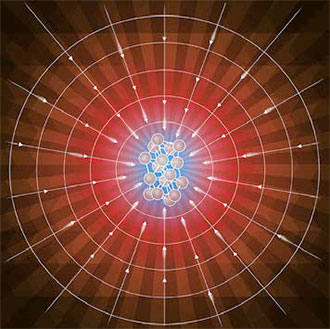
Figure 5. Artist’s concept of plutonium under the extreme pressures and temperatures produced by the Z machine.
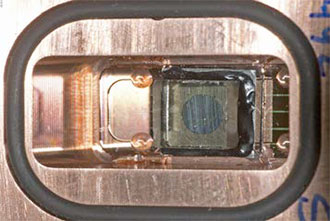
Photo. Plutonium alpha-phase metal samples are sandwiched between platinum sample holders and transparent lithium-fluorite windows and mounted in Z target copper panels. Los Alamos makes the target assemblies.
The Sandia Z Machine induces “shockless” magnetic compression that allows researchers to put plutonium into conditions not available with any other experimental driver. These experiments both improve the fundamental understanding of how plutonium behaves in a dynamic environment and how that dynamic performance might change with age, sometimes looking at new material and comparing it against older material from the stockpile. A more complete phase diagram is important to nuclear weapons designers who need to understand if a nuclear weapon will perform as designed and how it will be affected by aging.
Researchers fabricated disks or squares of mirror-finished plutonium (8 to 12 millimeters in diameter and 1/10 to 1/2 of a millimeter thick) and housed them in a target assembly. Then the team from Los Alamos and Sandia directed immense electrical energy onto the target with the Z Machine. This energetic, pulsed-power device creates a uniform, very fast magnetic pressure wave that compresses the plutonium sample, causing its phase to change, essentially reordering its atomic structure. Plutonium is a complex material possessing multiple solid phases and a liquid phase. Understanding where these phase transitions occur in dynamic settings will help researchers develop a phase diagram that describes where the phase boundaries are in terms of pressure, temperature, and density.
LANL’s role in these ongoing experiments includes producing the plutonium samples (target assemblies), which Nuclear Materials Science (MST-16) fabricates in collaboration with Materials Science and Technology (MST) Division, Shock and Detonation Physics group (M-9) in Explosive Science and Shock Physics (M) Division, and Sandia National Laboratories.
These experiments are part of the Stockpile Stewardship Program to ensure the safety, security, and effectiveness of the U.S. nuclear deterrent without the need for full-scale nuclear testing. NNSA Science Campaign 2 (Dana Dattelbaum, Program Manager) funded the Los Alamos work, which supports LANL’s Nuclear Deterrence mission area and the extreme environments subcategory of the Materials for the Future science pillar. Technical contact: Russell Olson (Neutron Science and Technology, P-23 and LANL Science Campaign 2 Project Leader)
Theoretical
Model predicts what happens when an electron collides with molecular hydrogen
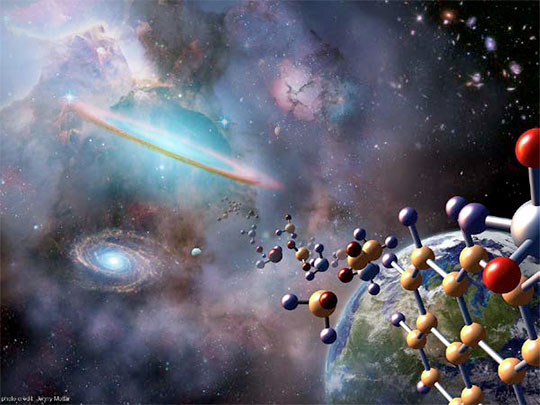
Figure 8. Artist’s concept of molecules in space. Credit: Jenny Mottar/NASA
Molecular hydrogen (H2) is the most abundant and simple neutral molecule in the universe. However, after many decades of research, predictions of chemical reactions involving the H2 molecule remained quantitatively inconsistent with measurements and the problem was largely unsolved. A research team including Mark Zammit, a post-doctoral fellow in Physics and Chemistry of Materials (T-1) and a member of the NNSA Advanced Simulation and Computing Physics and Engineering Models (ASC PEM) Atomic Physics Team, and colleagues at Curtin University in Australia solved this 100-year-old fundamental chemistry problem. The investigators developed a model to predict what happens when an electron (e-) collides with H2 (i.e., e- + H2), which theoretically is one of the simplest chemical interactions. This is the first method to produce very accurate and comprehensive electron-molecule scattering results. The journal Physical Review Letters published the results of the research.
Molecular hydrogen is present in interstellar space and in the atmospheres of gas giants and the outermost planets in our Solar System. It is also present at the edge region of fusion devices and widely used in plasma processing. A range of applications using H2 requires accurate and comprehensive electron-collision data of molecular hydrogen in order to interpret spectroscopic data and model astrophysical and technological plasmas. Moreover, chemical reactions are the basis of life. Therefore, accurately predicting what happens during chemical reactions is of great importance to science and has major implications in innovation, industry, and medicine.
The team started from the first principles of quantum mechanics and used super computers to calculate accurately the probability of chemical reactions, such as the ionization (removal of an electron) or electron excitation of H2 from e- + H2 collisions. Figure 9 reveals that these new results are in excellent agreement with accurate experiments. The findings indicate that this method is correct across the entire energy range, with elastic, excitation, and ionization reactions taken into account accurately. Moreover, the formalism is general and could be extended readily to other molecules where the interaction is dominated by one or two-electron excitations.
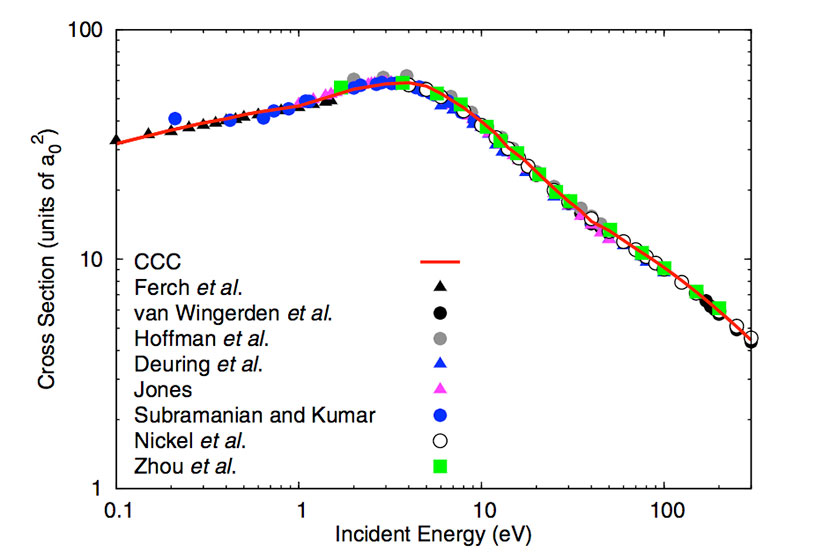
Figure 9. Grand total cross section of electron scattering from H2. Model results (convergent close coupling method, CCC) are in good agreement with experimental measurements.
The electron-molecule scattering field provides data to plasma physicists, astrophysicists, biophysicists, and medical doctors (e.g., determination of dosimetry during radiotherapy). This method has applications in the modeling of fusion plasmas, design of aerospace materials (for atmospheric entry), and plasma processing of materials. For example, the magnetic fusion reactor ITER has been designed to prove the feasibility of fusion as a large-scale and carbon-free source of energy based on the same principle that powers our Sun and stars. Molecular hydrogen molecule and its analogs composed of other hydrogen isotopes (deuterium and tritium) are significant species at the edge of magnetically confined fusion plasma devices. The species at the edge of the plasma play a vital role in controlling the dynamics within the plasma. The data are essential in order to perform accurate modeling of the plasma. In other applications, the team provides data to the International Atomic Energy Agency (IAEA). The model will help scientists answer basic questions about nature, such as the cooling mechanisms of the early universe and the formation of planets and stars.
Reference: “Complete Solution of Electronic Excitation and Ionization in Electron-Hydrogen Molecule Scattering,” Physical Review Letters 116, 2332016 (2016); doi: 10.1103/PhysRevLett.116.23320. Authors: Mark C. Zammit (Physics and Chemistry of Materials, T-1 and Curtin University), Jeremy S. Savage, Dmitry V. Fursa, and Igor Bray (Curtin University).
The U.S. Air Force Office of Scientific Research, LANL, and NNSA Advanced Simulation and Computing Physics and Engineering Models (ASC PEM) funded the LANL work. The research supports the Lab’s Nuclear Deterrence and Energy Security mission areas and the Nuclear and Particle Futures and Science of Signatures science pillars. Technical contact: Mark Zammit





